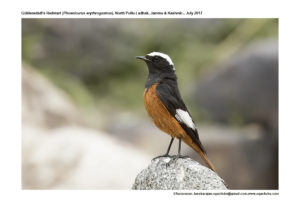Guldenstad’s Redstart

White-winged Redstart (Guldenstadt’s Redstart) Phoenicurus erythrogastrus
Etymology:
- Phoenicurus : Greek word phoinix –crimson, red, purple; ouros–tailed
- Erythrogastrus : Greek word eruthros- red; gaster –belly
Distribution in India: Resident and Winter Visitor in Himalayan range
Description: Size of 14-15 cm; wt. of 21–29 g.Male has black face to upper breast, back and wings, white crown and large wing patch, rufous-orange rump and tail, rufous-orange lower breast to under tail-coverts; black bill and legs. Female is plain mid-brown with dull rufous-orange tail, slightly buffy wing panel.The juvenile is brown with buff spotting above, buff with brown mottling below, densest on breast, tail as in female; young male has white wing patch.
Habits:It is found in in dry stream beds, boulder-strewn alpine meadows, stone fields and screes with some trees and herbs, flat parts of high passes, mountain gorges. Found in Himalayas at 3900–4800 m; requires combination of rugged rocky terrain and patches of cold-tolerant vegetation. Winters in rocky, scrubby hillsides near streams and riverbeds, rocky moraines, and thickets in valley bottoms, at 1500–4800 m
Food Habits: It eats in summer exclusively invertebrates, mostly insects and spiders. In winter it eats berries.
Breeding Habits: They breed in Jun-July.Nest is a bulky cup of grass and wool, lined with animal hair and feathers, placed well inside crevice in cliff or deep under rocks often near permanent snow-line. They lay a clutch of 3–5 eggs. The incubation period is 12–16 days; nestling period is 14 days; post-fledging dependence is at least 7 days.